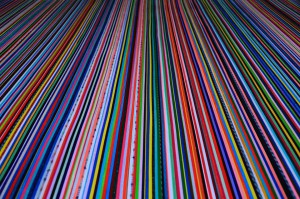[オープンスタジオ] 2018.2.21 wed 「Surfaith: Open studio with artist Tengshing Kazama」
2/24まで滞在している「Sa Sa Art Projects」にてオープンスタジオを開催します。
【Surfaith: 風間天心 オープンスタジオ】
日時:2018年2月21日(水) 14:00〜20:00
レセプションスタート 18:00
会場:Sa Sa Art Projects #47, St 350 (off St 95)
Sa Sa Art Projectsでは、Pisaot artists-in-residence プログラムとして6週間滞在しているアーティストTengshing Kazamaによるオープンスタジオを開催します。 今回の滞在は、「平成29年度アーティスト・イン・レジデンス活動支援を通じた国際文化交流促進事業札幌市文化芸術振興助成金」からの助成、NPO法人S-AIR Sapporoからの支援により可能となりました。
風間天心は日本の僧侶という立場から、風習や作法の背景にある日常的な「信仰」をリサーチしています。彼は2011年の日本の大地震から始まった[Ebb]シリーズを発表する予定です。今回は、Sa Sa Art Projectsでの滞在中に制作した新作が展示されます。
「Ebb」シリーズ
「水引」は、日本の伝統的な贈答用包装リボンです。室町時代(1336-1573)に中国から入ってきたこの文化は、輸入品を区別するための目印とセキュリティ(封緘)として使用されていました。しかし、日本人はそれを特別な贈答品を示す装飾として理解しました。日本人は物事をアレンジすることに優れているため、「中国文化」を自らの伝統文化としてアレンジし、発展させました。そして彼は現在、その「日本文化」としての水引を、よりグローバルな「西洋文化」である絵画として再度アレンジしました。
日本は現在、物理的な波、社会的な波に脅かされています。しかし、どんな波に飲まれたあとでも、形を変えて残っていくのが真の文化です。そしてそれが変化する過程で、摩耗され、濾過され、昇華された「信仰」が浮き彫りになります。
【水/水】=水【引/ひき】=引く、後退する
【Surfaith: Open studio with artist Tengshing Kazama 】
Wednesday 21st February 2018, 2pm – 8pm
Sa Sa Art Projects #47, St 350 (off St 95)
More information: info@sasaart.info | 092 78 78 67
Studio opens from 2pm
Reception starts at 6pm
Sa Sa Art Projects is pleased to welcome you to an open studio by our current Pisaot artists-in-residence Tengshing Kazama, who has spent the last six weeks in Cambodia. This residency is made possible through the support from Japan’s Agency for Cultural Affairs and Sapporo City Fund for Arts and Cultural Promotion through NPO S-AIR Sapporo, Japan.
Tengshing Kazama researches the everyday “faith” in the background of customs and practices from the standpoint of a Japanese monk. He will present “Ebb” series which started from 2011’s Japanese big earthquake. All the works to be presented at the open studio are new works that he made during his stay at Sa Sa Art Projects.
“Ebb” (水引/Mizuhiki) is a Japanese traditional wrapping ribbon for special gifts. It had originally brought to japan from China in Muromachi Period (1336-1573). During commercial transactions, the Chinese used it as a visual mark to distinguish the imported goods from the others and as a security key. But then the Japanese mistakably understood it as a special gift-wrapping ribbon to tie a special gift. As the Japanese being remarkably good at arranging things, the ancient Japanese people had arranged and developed this Chinese culture into it’s own traditional culture. And now, the artist has restored the 水引/Mizuhiki to its original material and re-arranged it as a western painting to make it global.
Although Japan is constantly being threatened by both physical and social waves. However, the thing which will always be remained even after it getting swallowed up by these big waves, is the culture, no matter how it changes from its original look. In the course of its changes—be polished, be filtered, and be sublimed—“faith” floats up. (水/Mizu) = water (引/Hiki) = to draw, to retreat.

